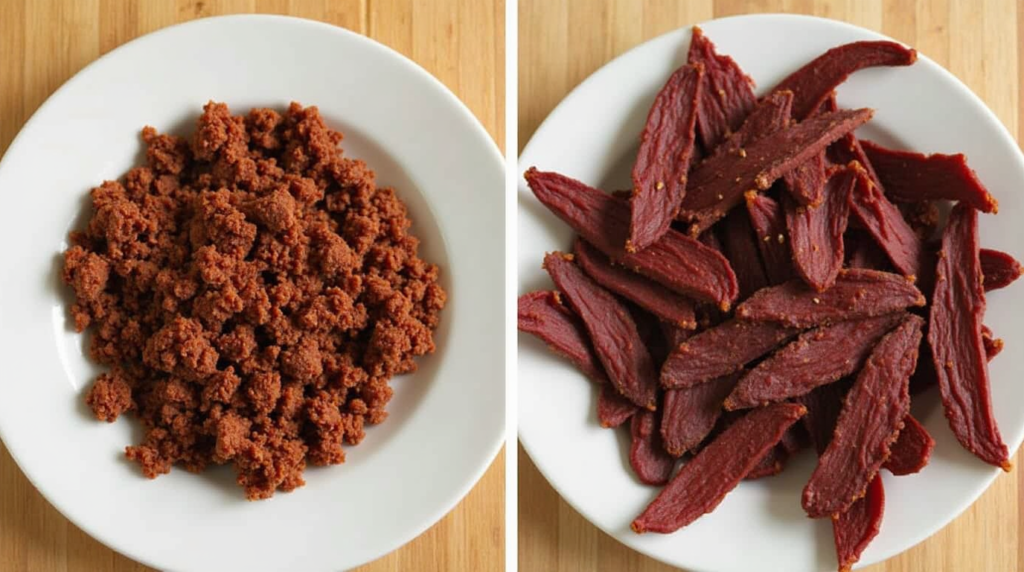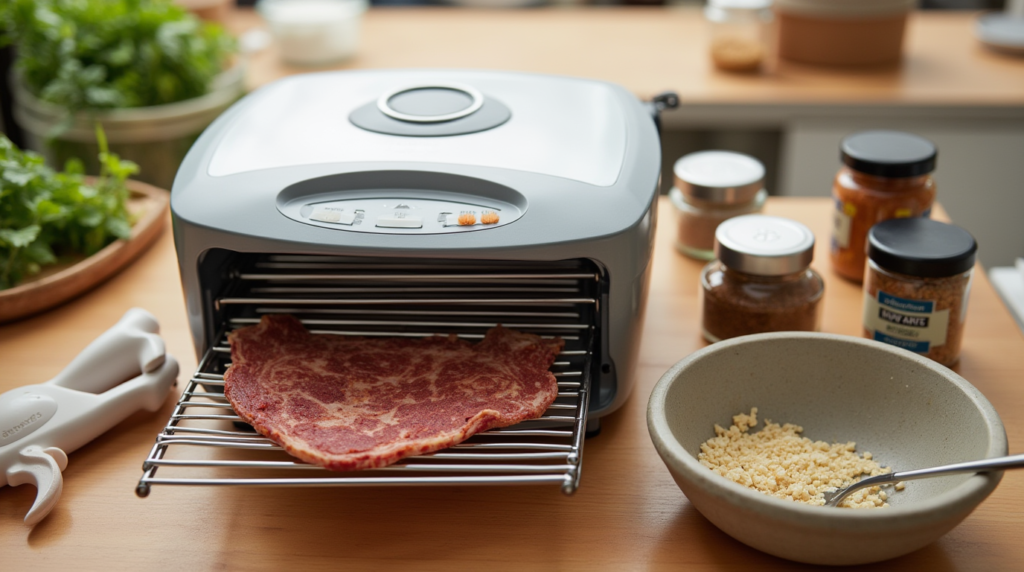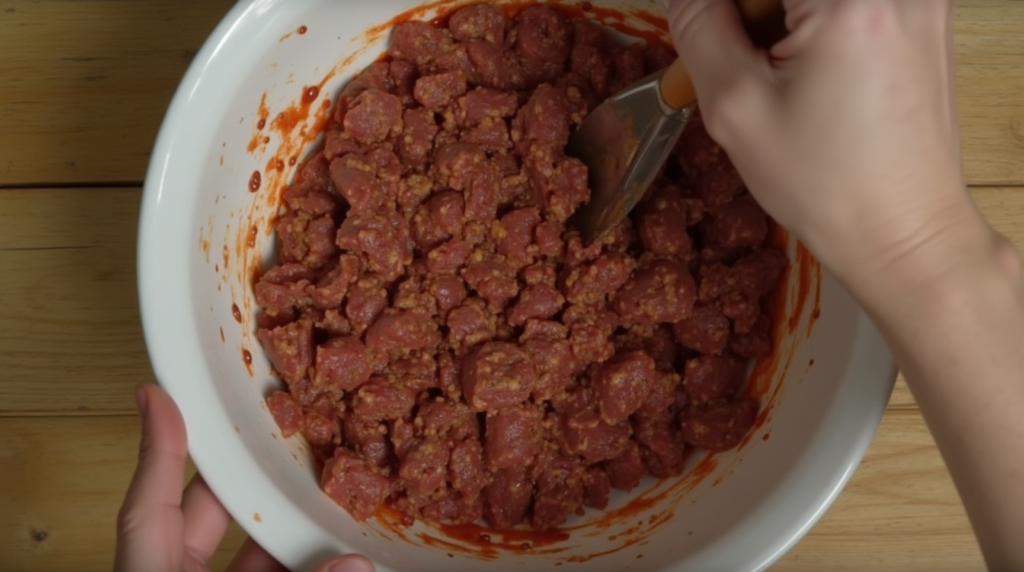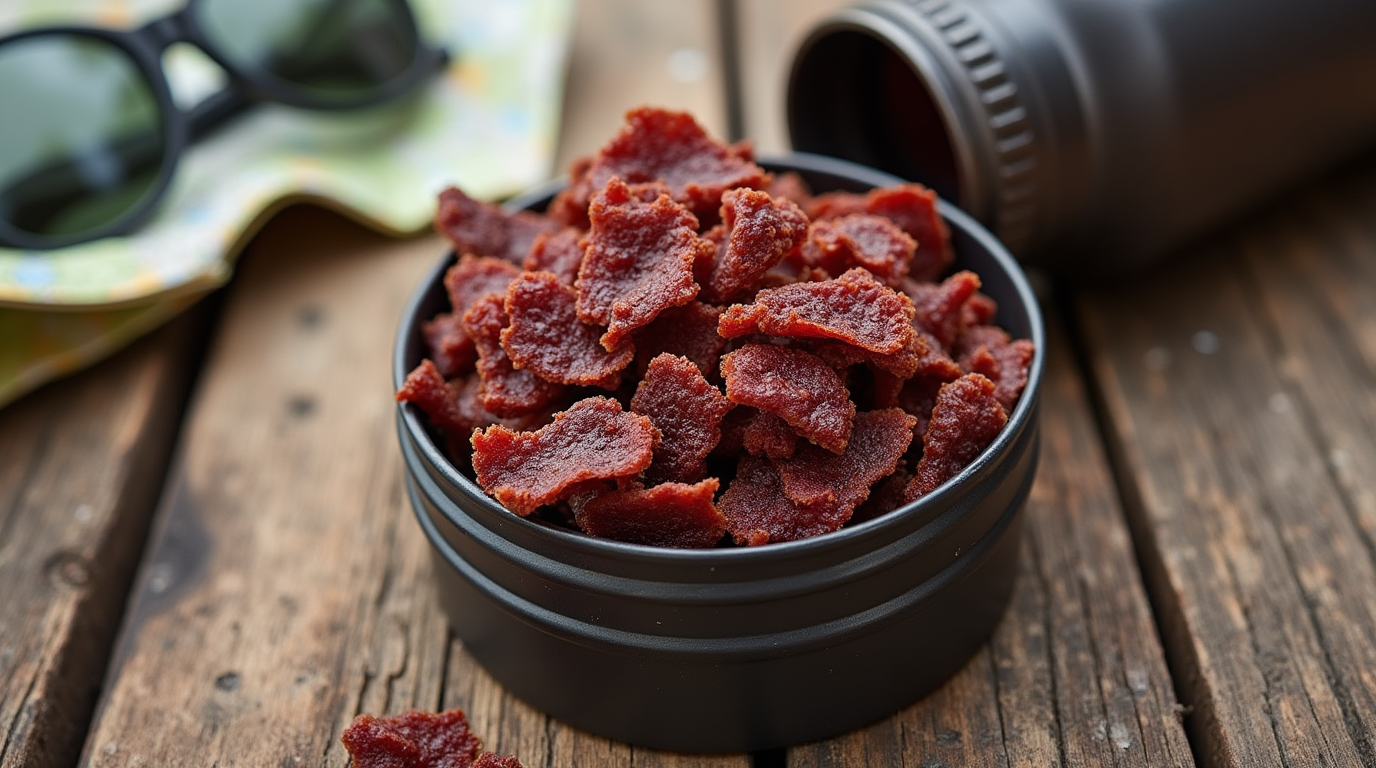Easy Ground Beef Jerky Recipe – Homemade & Flavor-Packed
Are you looking for a simple and delicious snack to take on the go? Look no further! Making Ground beef jerky is easier than you think, and using ground beef gives it a unique twist.
You can create a flavor-packed snack that’s perfect for hiking, road trips, or just a quick energy boost. With a few basic ingredients and some simple equipment, you’ll be enjoying your favorite beef jerky in no time.
Key Takeaways
- Learn how to make a delicious and easy ground beef jerky recipe at home.
- Discover the benefits of using ground beef to make jerky.
- Get an introduction to the essential equipment and ingredients needed.
- Create a flavor-packed snack perfect for on-the-go.
- Enjoy a healthy and protein-rich snack that’s easy to make.
Why Ground Beef Makes Excellent Jerky
The use of ground beef in jerky production offers several advantages over conventional methods. Ground beef jerky is not only delicious but also easy to make and customize to your taste preferences. By grinding the beef, you can ensure a uniform texture that is both tender and chewy, making it a hit with both adults and kids.

Benefits Over Traditional Whole Muscle Jerky
One of the primary benefits of ground beef jerky is its texture. Unlike traditional whole muscle jerky, which can sometimes be tough and chewy, ground beef jerky is consistently tender. This is because the grinding process breaks down the meat fibers, making it easier to achieve a uniform texture. Additionally, ground beef jerky allows for a more even distribution of flavors, as the seasonings can be mixed directly into the meat.
Furthermore, using ground beef enables you to create a variety of flavors by mixing in different seasonings and marinades before drying. This flexibility is a significant advantage over traditional jerky methods, where seasonings are typically applied to the surface. You can make a flavorful beef jerky by incorporating your favorite spices and herbs into the ground beef mixture.
Cost-Effectiveness and Accessibility
Ground beef is generally more affordable than the cuts of meat used for traditional jerky. This cost-effectiveness makes it an attractive option for those looking to make jerky at home without breaking the bank. To learn how to make beef jerky at home, you can start by purchasing ground beef from your local supermarket.
Using ground beef also simplifies the jerky-making process. Since the meat is already ground, you can skip the step of slicing or cutting the meat into thin strips, which can be time-consuming and sometimes challenging, especially for those without experience handling meat. With a simple recipe, you can create a best beef jerky recipe that suits your taste.
Essential Equipment for Making Ground Beef Jerky
Creating savory beef jerky at home requires some essential tools. To achieve that perfect blend of flavor and texture, you’ll need to invest in a few key pieces of equipment. The right tools not only make the process easier but also ensure that your ground meat jerky turns out delicious and consistent every time.

Dehydrators vs. Ovens
When it comes to drying your ground beef jerky, you have two primary options: using a dehydrator or your oven. Dehydrators are specifically designed for drying foods and offer precise temperature control, which is ideal for making jerky. They circulate air around the meat, ensuring an even drying process. On the other hand, ovens can be used if you don’t have a dehydrator, but you’ll need to be cautious with the temperature and keep the door slightly ajar to prevent overcooking.
- Dehydrator Advantages: Even drying, precise temperature control, and less risk of overcooking.
- Oven Advantages: Readily available, no need for additional equipment.
Jerky Guns and Other Helpful Tools
A jerky gun is a valuable tool for making ground meat jerky. It allows you to extrude the meat mixture into uniform strips, making the drying process more efficient and the final product more consistent. Other helpful tools include a meat grinder or food processor for mixing and grinding the meat, and a marinade container for flavoring your jerky.
- Jerky Gun Benefits: Uniform jerky strips, easier to achieve consistent drying.
- Other Tools: Meat grinder for custom grind sizes, marinade container for better flavor infusion.
Selecting the Right Ground Beef for Jerky
Choosing the right ground beef is crucial for making delicious homemade beef jerky. The quality and composition of the ground beef can significantly affect the final product’s taste, texture, and overall quality.
Lean-to-Fat Ratio Considerations
The lean-to-fat ratio is a critical factor when selecting ground beef for jerky. A ratio that is too lean may result in jerky that is too dry, while too much fat can make it overly greasy. Ideally, you want a balance that provides enough moisture without compromising the jerky’s shelf life.
For easy beef jerky, a lean-to-fat ratio of 80/20 or 85/15 is often recommended. This balance ensures that your jerky is both flavorful and has a good texture.
| Lean-to-Fat Ratio | Characteristics | Suitability for Jerky |
|---|---|---|
| 90/10 | Very lean, potentially dry | Less ideal, may be too dry |
| 80/20 | Balanced, flavorful | Highly suitable |
| 70/30 | High fat content, potentially greasy | Less ideal, may spoil faster |
Quality Matters: Grass-Fed vs. Conventional
The quality of ground beef also depends on whether it is grass-fed or conventionally raised. Grass-fed beef tends to have a leaner profile and a more robust flavor, which can be advantageous for jerky. However, it can also be more expensive.
Conventional ground beef, on the other hand, may have a higher fat content and a milder flavor. It’s often more affordable but might require more trimming.
For the best beef jerky recipe, consider using grass-fed ground beef for its superior flavor profile, but conventional ground beef can also produce excellent results if you adjust your expectations accordingly.
The Best Ground Beef Jerky Recipe for Beginners
Creating delicious ground beef jerky at home is easier than you think, and it all begins with a solid recipe. With a few simple ingredients and some basic equipment, you can make a tasty and convenient snack that’s perfect for on-the-go. In this section, we’ll walk you through the base ingredients list, marinade preparation, and mixing and seasoning techniques to get you started.
Base Ingredients List
To make ground beef jerky, you’ll need a few key ingredients. Start with 1 pound of ground beef, preferably with a lean-to-fat ratio of 90/10 or 85/15. You’ll also need:
- 1/4 cup of soy sauce or tamari
- 1/4 cup of brown sugar
- 1 tablespoon of smoked paprika
- 1 teaspoon of garlic powder
- 1 teaspoon of onion powder
- 1 teaspoon of salt
- 1/2 teaspoon of black pepper
These ingredients will provide a solid foundation for your jerky, but feel free to experiment with different seasonings and marinades to find your favorite flavor.
Marinade Preparation
The marinade is a crucial step in making flavorful ground beef jerky. In a large bowl, combine the soy sauce, brown sugar, smoked paprika, garlic powder, onion powder, salt, and black pepper. Mix well until the sugar is dissolved, then add the ground beef. Use your hands or a spoon to mix the meat and marinade until just combined. Be careful not to overmix, as this can lead to tough jerky.

Cover the bowl with plastic wrap and refrigerate for at least 4 hours or overnight. This will allow the flavors to penetrate the meat and the texture to become more tender.
Mixing and Seasoning Techniques
After the marinade has done its job, it’s time to mix and season the meat. Remove the bowl from the refrigerator and give the mixture a gentle stir. If you want to add any additional seasonings, now is the time to do so. Some options include dried herbs, grated ginger, or diced jalapeños.
Use a jerky gun or a piping bag to form the meat mixture into long, thin strips. Alternatively, you can shape the mixture by hand into strips or logs. The key is to create uniform pieces so that they dry evenly.
By following these steps and using the right ingredients, you’ll be well on your way to making delicious ground beef jerky at home. Experiment with different flavors and techniques to find your perfect recipe.
Step-by-Step Preparation Process
The key to making great ground meat jerky lies in its preparation. To achieve savory beef jerky that’s full of flavor, follow these detailed steps carefully.
Preparing Your Meat Mixture
Start by preparing your meat mixture, which involves combining ground beef with your chosen marinade ingredients. In a large bowl, mix together 1 pound of ground beef with your preferred seasonings and marinade. Use your hands or a spoon to ensure the mixture is well combined. The goal is to distribute the flavors evenly throughout the meat, creating delicious beef jerky that’s consistent in taste.
Loading and Using a Jerky Gun
A jerky gun is a handy tool that helps you achieve uniform strips of jerky. To use a jerky gun, fill it with your prepared meat mixture, making sure to pack it tightly to avoid air pockets. Then, extrude the mixture onto a parchment-lined surface or directly onto dehydrator trays. This method helps you create professional-looking ground meat jerky with ease.
Alternative Forming Methods
If you don’t have a jerky gun, you can still make great jerky using alternative methods. Simply shape the meat mixture into thin strips by hand, or use a spatula to spread it onto a baking sheet lined with parchment paper. This approach allows you to achieve the desired thickness and texture for your jerky.
Arranging on Dehydrator Trays or Baking Sheets
Once you’ve formed your jerky, it’s time to arrange it on dehydrator trays or baking sheets. Make sure to leave space between each strip to allow for even drying. If using a dehydrator, follow the manufacturer’s instructions for temperature and time settings. For oven drying, set your oven to its lowest temperature setting and keep the door slightly ajar to promote airflow.
| Preparation Method | Equipment Needed | Tips for Best Results |
|---|---|---|
| Using a Jerky Gun | Jerky Gun, Parchment Paper | Pack the mixture tightly, extrude onto trays |
| Hand-Forming | None | Shape into thin strips, uniform thickness |
| Oven Drying | Oven, Baking Sheets, Parchment Paper | Lowest temperature, door slightly ajar |
Drying Methods and Times
Once you’ve prepared your ground beef mixture, it’s time to dry it to perfection using one of several effective methods. The drying process is critical in making ground beef jerky, as it directly affects the texture and flavor.
Dehydrator Instructions
Using a dehydrator is one of the most popular methods for drying ground beef jerky. It allows for even drying and can help preserve the flavor. To use a dehydrator, follow these steps:
- Preheat the dehydrator to 160°F (or the temperature recommended by the manufacturer).
- Spread the ground beef mixture onto the dehydrator trays in a thin layer.
- Dehydrate for 3-4 hours, or until the jerky reaches your desired level of dryness.
Tips for Dehydrator Use: Ensure that the jerky is not overcrowded on the trays, as this can affect drying time. You can also rotate the trays halfway through the drying process for more even results.
Oven-Baking Method
If you don’t have a dehydrator, you can use your oven to dry ground beef jerky. Here’s how:
- Preheat your oven to its lowest temperature setting, usually around 150°F to 200°F.
- Line a baking sheet with parchment paper or a silicone mat.
- Spread the ground beef mixture onto the prepared baking sheet in a thin layer.
- Place the baking sheet in the oven, leaving the door slightly ajar to allow moisture to escape.
- Dry for 3-4 hours, checking periodically to ensure the jerky doesn’t overcook.
Note: The oven method may not produce jerky as evenly dried as a dehydrator, but it’s a viable alternative.
How to Test for Doneness
Regardless of the drying method you choose, it’s crucial to test your jerky for doneness. Properly dried jerky should be dry and chewy but not brittle. Here’s how to check:
| Texture | Description | Action |
|---|---|---|
| Too Dry/Brittle | Jerky breaks easily or is overly dry. | Reduce drying time. |
| Too Moist | Jerky feels wet or sticky. | Increase drying time. |
| Just Right | Jerky is dry, chewy, and slightly flexible. | Perfect! Store or enjoy. |
By following these drying methods and testing for doneness, you can achieve perfectly dried homemade beef jerky that’s both delicious and safe to eat. Making easy beef jerky at home is a simple process that yields a tasty snack, and with these tips, you’re on your way to creating the best beef jerky recipe for your taste preferences.
5 Delicious Flavor Variations for Your Ground Beef Jerky Recipe
Elevate your snacking game with these 5 mouth-watering flavor variations for your ground beef jerky recipe. Whether you’re a fan of classic flavors or adventurous taste buds, these variations will help you create a diverse range of flavorful beef jerky to suit any taste.
Classic Smoky BBQ
Start with a timeless favorite: Classic Smoky BBQ. This flavor combines the richness of smoked paprika, the tanginess of apple cider vinegar, and a hint of brown sugar to create a savory beef jerky that’s hard to resist. Simply add 1 tablespoon of smoked paprika, 1 tablespoon of brown sugar, and 2 tablespoons of apple cider vinegar to your ground beef mixture.
Spicy Sriracha
For those who like a little heat, the Spicy Sriracha variation is a must-try. By incorporating sriracha sauce into your marinade, you’ll achieve a delicious beef jerky with a spicy kick. Mix in 2 tablespoons of sriracha sauce, 1 tablespoon of soy sauce, and 1 tablespoon of honey for a flavor that’s both spicy and sweet.
Sweet and Savory Teriyaki
Teriyaki lovers will enjoy this sweet and savory variation. By blending soy sauce, brown sugar, and ginger, you’ll create a flavorful beef jerky that’s both sweet and umami. Combine 2 tablespoons of soy sauce, 1 tablespoon of brown sugar, and 1 teaspoon of grated ginger for a teriyaki flavor that’s sure to please.
Zesty Southwest
Transport your taste buds to the Southwest with this zesty variation. Featuring chili powder, lime juice, and cumin, this savory beef jerky is perfect for those who enjoy bold flavors. Mix in 1 tablespoon of chili powder, 2 tablespoons of lime juice, and 1 teaspoon of cumin for a flavor that’s distinctly Southwestern.
Garlic Pepper
Lastly, for a simple yet satisfying flavor, try the Garlic Pepper variation. With a generous amount of minced garlic and coarse black pepper, this delicious beef jerky is sure to become a favorite. Add 2 cloves of minced garlic and 1 tablespoon of coarse black pepper to your ground beef mixture for a flavor that’s both aromatic and peppery.
These 5 delicious flavor variations offer a range of options to enhance your ground beef jerky recipe. Whether you’re in the mood for something classic and smoky or spicy and adventurous, there’s a flavor to suit every taste. Experiment with these variations to create your perfect flavorful beef jerky.
Troubleshooting Common Ground Beef Jerky Problems
Troubleshooting is an essential skill for anyone making homemade beef jerky. Even with a well-crafted ground beef jerky recipe, issues can arise during the preparation process. Understanding how to address these problems can ensure your final product is delicious and safe to eat.
Too Dry or Too Moist
If your jerky turns out too dry, it might be due to over-drying. To avoid this, monitor the dehydration time closely. On the other hand, if your jerky is too moist, it may not have been dried long enough, or it might be a sign of improper storage. Adjusting the drying time or checking your storage methods can help. For homemade beef jerky, it’s crucial to strike the right balance.
Addressing Texture Issues
Texture issues can be a significant problem. If your jerky is too crumbly, it could be due to over-processing the meat mixture. Conversely, if it’s too chewy, it might not have been dried sufficiently. Ensuring the right balance during preparation is key when learning how to make beef jerky.
Preventing Spoilage
Preventing spoilage is crucial when making homemade beef jerky. Always store your jerky in airtight containers and keep it in a cool, dry place. Regularly check for signs of spoilage, such as off smells or mold. Proper handling and storage can significantly extend the shelf life of your jerky.
| Issue | Cause | Solution |
|---|---|---|
| Too Dry | Over-drying | Monitor dehydration time |
| Too Moist | Insufficient drying or improper storage | Adjust drying time or storage methods |
| Texture Issues | Over-processing or insufficient drying | Balance preparation and drying |
By understanding and addressing these common issues, you can perfect your ground beef jerky recipe and enjoy a delicious, homemade snack.
Conclusion
Now that you’ve learned how to make easy beef jerky using ground meat, it’s time to get creative with your best beef jerky recipe. With the simple steps outlined in this article, you can enjoy a variety of flavors and textures in your homemade ground meat jerky.
Experimenting with different marinades and seasonings can help you find your perfect match. Whether you’re a fan of classic smoky BBQ or spicy Sriracha, the versatility of ground beef jerky allows you to tailor your easy beef jerky to suit any taste preference.
By following the guidelines provided, you’re well on your way to creating delicious ground meat jerky that’s both healthy and convenient. So, don’t be afraid to try new flavors and techniques to make your best beef jerky recipe.
FAQ
What is the best type of ground beef to use for making beef jerky?
The best type of ground beef to use for making beef jerky is lean ground beef with a lean-to-fat ratio of 90/10 or 95/5. This ratio ensures that your jerky is not too greasy and has a better texture.
Can I use a conventional oven to dry my ground beef jerky?
Yes, you can use a conventional oven to dry your ground beef jerky. To do this, set your oven to its lowest temperature setting and prop the door open slightly to allow moisture to escape. Keep an eye on the jerky to prevent overcooking.
How long does it take to dry ground beef jerky in a dehydrator?
The time it takes to dry ground beef jerky in a dehydrator can vary depending on the temperature and the thickness of the jerky strips. Generally, it takes around 3-6 hours at 135°F to 155°F (57°C to 68°C).
What are some common issues with homemade ground beef jerky and how can I troubleshoot them?
Common issues with homemade ground beef jerky include it being too dry or too moist, texture issues, and spoilage. To troubleshoot these issues, check your drying time and temperature, ensure proper handling and storage, and adjust your recipe as needed.
Can I make ground beef jerky without a jerky gun?
Yes, you can make ground beef jerky without a jerky gun. Alternative methods include shaping the meat mixture by hand into strips or using a piping bag with a large round tip to create uniform strips.
How do I store homemade ground beef jerky to maintain its freshness?
To store homemade ground beef jerky, place it in an airtight container, such as a glass jar or a resealable plastic bag, and keep it in a cool, dry place. You can also store it in the refrigerator or freezer to extend its shelf life.
What are some flavorful variations I can try for my ground beef jerky recipe?
You can try various flavor variations, such as classic smoky BBQ, spicy sriracha, sweet and savory teriyaki, zesty southwest, and garlic pepper, by adjusting the marinade ingredients and seasonings in your recipe.
Leave a Review & Rate This Recipe!
There are no reviews yet. Be the first one to write one.

